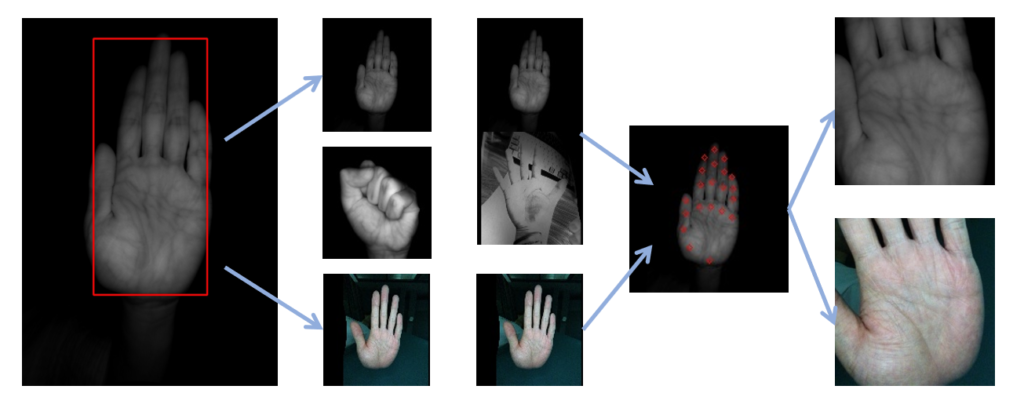When it comes to biometric authentication in payment systems, palm vein recognition stands out due to its high accuracy and security. However, not all palm vein readers are created equal. One of the most significant distinctions lies in the type of imaging technology used—specifically, whether the device uses IR (Infrared) imaging or combines both RGB (color) and IR. Many customers may assume that a device with two cameras automatically includes both RGB and IR, but this is not always the case. Let’s dive into the details and clarify the difference, especially when it comes to high-security applications like payment systems.
IR vs. RGB+IR: The Key Difference
Palm vein recognition works by capturing unique patterns of veins inside the palm, which are as distinctive as fingerprints. To accurately capture these patterns, the system uses imaging technology that includes either infrared (IR) or both IR and RGB cameras.
- IR Imaging (Infrared Only):
IR cameras capture palm vein patterns by emitting infrared light, which passes through the skin and reflects off the veins. This method allows for high accuracy in detecting veins, but it only captures the vein structure, not the surface palm print. This is where many devices, like Fujitsu’s palm vein module, fall short. - Fujitsu’s palm vein module only supports IR imaging, which means it captures only the vein pattern. While this can still be used for authentication, it lacks the critical feature of comparing the palm print (RGB) and the vein pattern together. This can create limitations, especially in high-security scenarios like financial transactions.
- RGB+IR Imaging (Dual Camera Setup):In contrast, palm vein readers that utilize both RGB and IR cameras capture two crucial data points simultaneously: the palm print (using RGB technology) and the vein structure (using IR technology). The RGB camera captures a detailed image of the surface of the palm, including ridges and features of the skin. The IR camera detects the palm vein pattern underneath the surface.
- This dual-camera approach is crucial for ensuring the highest level of security. By comparing the palm print and vein patterns together, the system can match them and confirm their authenticity, providing much more reliable and accurate results. This is particularly important in high-stakes environments like payment systems, where security is non-negotiable.
Don’t Be Misled by Appearances: Two Cameras Don’t Always Mean RGB+IR
One of the most common misconceptions is that if a device has two cameras, it must support both RGB and IR. This is not always the case. A device might have two cameras, but they may both be infrared cameras, or they might only have a single RGB camera alongside an IR one, without integrating both technologies for biometric authentication.
As David, a hardware engineer from X-Telcom with over a decade of experience working on WeChat Payment platform integration, points out, it’s essential for customers to directly confirm with the manufacturer whether the device supports RGB imaging alongside IR. A two-camera setup does not automatically imply RGB+IR capability. It’s crucial to ask the manufacturer about the specific functions and technologies behind the cameras to ensure that both the palm print and vein patterns are being captured and processed.
The Role of RGB+IR in Payment Systems
The RGB+IR dual-camera configuration is especially important for payment systems, where security is paramount. In these scenarios, matching both the palm print and the vein pattern ensures that the biometric data being used for authentication is as accurate and secure as possible. The process typically involves comparing the palm print (RGB) and the vein pattern (IR), allowing the system to cross-check and validate both datasets at the same time.
The advantage of this dual-camera approach is that it significantly reduces the possibility of a false acceptance rate (FAR). When these systems use both RGB and IR technologies, the FAR can reach as low as 1e-6—meaning that the chance of an unauthorized user being incorrectly authenticated is incredibly rare, even when dealing with large biometric databases.
X-Telcom’s Palm Vein Reader, which supports the RGB+IR dual-camera setup, ensures that both the palm print and vein pattern are captured and compared simultaneously. This approach maximizes security and reduces the likelihood of fraudulent access, which is essential in financial environments.
Why RGB+IR is the Ideal Choice for Financial Applications
When choosing a palm vein reader for payment systems, security is the primary concern. Systems that use only IR imaging are simply not equipped to meet the high standards required for secure payments. Without the RGB camera, there’s no way to validate both the surface palm print and the vein structure together. As a result, relying on IR-only systems leaves payment applications vulnerable to errors and security risks.
The RGB+IR dual-camera configuration allows for a more robust and comprehensive analysis of the user’s palm. For businesses, this means fewer false positives and higher confidence that the person making the transaction is indeed who they say they are. This is why devices like X-Telcom’s Palm Vein Reader, which supports RGB+IR imaging, are particularly suited for financial institutions, retail environments, and other sectors that prioritize security.
Conclusion: Don’t Just Look at the Cameras—Check the Specs
In conclusion, when selecting a palm vein reader, don’t be misled by the number of cameras on the device. A two-camera setup does not always indicate RGB+IR functionality. It’s essential to confirm with the manufacturer whether both RGB and IR cameras are included and integrated for biometric authentication. Systems that only support IR imaging may not offer the level of security required for high-risk applications like payment systems.
For businesses that need top-tier security, particularly in financial transactions, RGB+IR palm vein readers are the ideal choice. These systems provide accurate, reliable, and secure authentication by simultaneously verifying both the palm print and the vein pattern, reducing the risk of fraud and improving overall security in payment applications.



